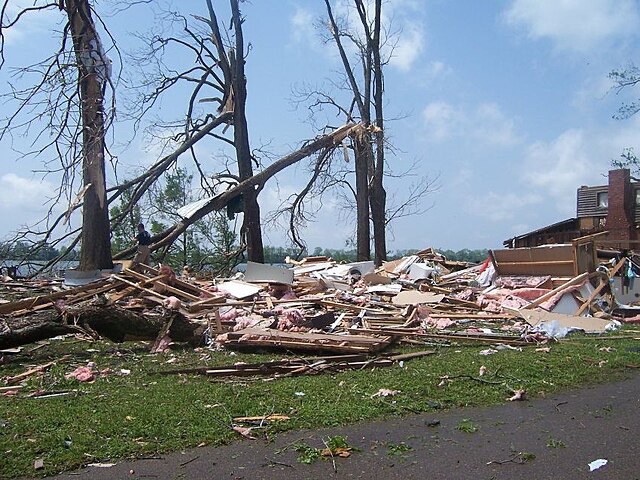A series of deadly tornadoes has devastated parts of Kentucky and Missouri, leaving at least 21 people dead and prompting officials to declare a “mass casualty event.” The storms ripped through homes, businesses, and infrastructure, leaving behind scenes of total destruction. The confirmed death toll includes 14 fatalities in Kentucky and seven in Missouri, with many others injured and thousands displaced.
The disaster has prompted emergency declarations, extensive search-and-rescue missions, and an outpouring of support across the nation. As local authorities battle to restore normalcy, meteorologists warn that the storm system may continue to wreak havoc in other parts of the Midwest.
Kentucky: The Epicenter of Tragedy
Kentucky bore the brunt of the tornado outbreak. Laurel County and surrounding areas experienced extreme weather conditions late Friday, with winds so powerful they leveled homes and flung vehicles like toys. Governor Andy Beshear confirmed that 14 Kentuckians lost their lives and warned the number may increase as rescue efforts continue.
Emergency crews are working around the clock to clear debris, search for survivors, and provide emergency medical care. Shelters have been set up in churches, schools, and community centers to house those who lost their homes.
Governor Beshear has declared a state of emergency and activated the Kentucky National Guard. “This is one of the most devastating weather events we’ve seen in recent years,” he said. “We are committed to helping every family rebuild.”
Missouri’s Destructive Storm Path
Missouri, too, was rocked by the tornadoes. St. Louis saw some of the most severe damage, with five confirmed deaths and over 5,000 homes reported as damaged or destroyed. Mayor Cara Spencer issued a city-wide curfew and described the scene as “catastrophic,” urging residents to stay indoors while emergency crews work.
Scott County, located about 130 miles south of St. Louis, was hit earlier in the day, resulting in two fatalities. Sheriff Derick Wheetley confirmed that homes were flattened, roads were blocked, and power lines were down.
Rescue operations in Missouri are being supported by over 500 first responders and 17 specialized search-and-rescue units. The full scope of damage is still being assessed.
The Wider Reach: Midwest Storm System
Beyond Kentucky and Missouri, the same storm system also triggered tornadoes and severe weather in Wisconsin, Illinois, and even New Jersey. Wisconsin reported tornado touchdowns and massive power outages that affected hundreds of thousands. Trees were uprooted, power lines snapped, and buildings heavily damaged.
The National Weather Service (NWS) has issued tornado watches for several other states and warned that the system could continue moving eastward, potentially affecting the Appalachian region and parts of the Northeast.
Timeline of the Tornado Outbreak
The chaos began Friday morning in Scott County, Missouri, before the system gained momentum and moved northeast into Kentucky by late afternoon. By Friday night, massive tornadoes had torn through communities, leaving little warning time.
Meteorologists reported wind speeds exceeding 140 mph in some areas and categorized some tornadoes as EF-3 or higher on the Enhanced Fujita scale—capable of severe destruction.
Weather alerts were issued, but the speed and strength of the storm overwhelmed many preparedness efforts.
Emergency Measures and State Response
Both Kentucky and Missouri governors issued emergency declarations to expedite federal aid. Curfews have been implemented in the hardest-hit areas to maintain order and prevent looting.
Federal Emergency Management Agency (FEMA) teams are on-site, coordinating with local authorities to assess damage and deploy resources. Mobile medical units, temporary housing, and food supply trucks are being deployed to affected zones.
Community Impact and Human Stories
From families who barely escaped collapsing homes to business owners surveying ruined shops, the human impact of the tornadoes is immeasurable. “We just ran into the basement and prayed,” said one Laurel County resident. “When we came back up, the roof was gone.”
Volunteers have been pouring into affected areas, distributing water, clearing rubble, and comforting survivors. Many are still searching for missing loved ones.
Rescue and Recovery Efforts Underway
Search-and-rescue operations are being conducted 24/7. Trained dogs, drones, and heat-sensing equipment are helping locate survivors beneath debris. Emergency shelters are operating at full capacity, offering food, bedding, and emotional support.
Medical teams are treating trauma injuries, hypothermia, and respiratory issues caused by dust and smoke inhalation.
Climate and Weather Experts Weigh In
Experts suggest that the intensity and frequency of such tornado outbreaks could be linked to climate change. Warmer temperatures and moisture-rich air create ideal conditions for violent storms. Scientists are now calling for further research and more robust early-warning systems.
How to Help and Donate
To assist those affected, consider donating to:
- American Red Cross
- Team Rubicon
- United Way Disaster Response
- Local church and community fundraisers
Volunteers are also being coordinated through regional emergency response agencies.
11. Conclusion
The tornadoes that swept through Kentucky and Missouri have inflicted deep scars on the landscape and on the hearts of residents. With 21 lives lost and countless others affected, the path to recovery will be long. But amid the wreckage, stories of survival, solidarity, and resilience continue to emerge. As the storm clouds clear, efforts now turn to rebuilding what was lost—and ensuring we are better prepared for what’s to come.
FAQs
Q1: How many people have died due to the tornadoes?
A1: At least 21 confirmed deaths—14 in Kentucky and 7 in Missouri.
Q2: Which areas were hit hardest?
A2: Laurel County in Kentucky and St. Louis in Missouri suffered the most significant damage.
Q3: Are rescue efforts still ongoing?
A3: Yes, search-and-rescue operations are underway with local and federal teams on-site.
Q4: What is being done for displaced residents?
A4: Emergency shelters, food banks, and mobile clinics have been set up in affected areas.
Q5: How can I help or donate?
A5: Donations can be made through reputable organizations like the Red Cross or United Way. Volunteering locally is also encouraged.



